
by Terri Cook Monday, July 2, 2018
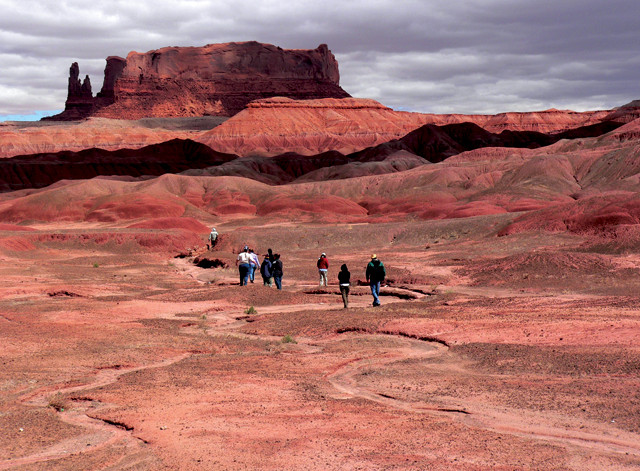
Arizona State University students participating in a place-based field trip near Round Rock in Arizona combined geological study with an exploration of indigenous and historic cultures of the Colorado Plateau. Credit: Steven Semken.
When geologist Kent Kirkby first joined the faculty in the University of Minnesota’s Department of Earth Sciences in 1994, he was assigned to teach a large, entry-level geoscience course that had last been revised in the 1970s. “While that revision had been very innovative for its time,” Kirkby says, “it was showing its age.” As he mulled options for redesigning the course, he learned through class surveys that less than 1 percent of the roughly 1,000 students who enrolled in it each year were considering a career related to earth science, and that it was also the last physical science class that more than three-quarters of the students intended to take. Given those statistics, “teaching the course as a traditional introductory science class made no sense,” he says.
Kirkby instead created a “concluding” science course — one that, in his vision, would focus on skills and concepts that students need to become informed citizens of a global community facing difficult environmental issues. His goal was to harness regional case studies to showcase societal relevance and assign course activities that applied geologic concepts to give students what he describes as “an appreciation of the close interactions between Earth processes and human society.”
Around this time, Kirkby met Steven Semken, an MIT-trained geologist who was teaching at Diné College, the tribal college of the Diné (Navajo) Nation. Semken told Kirkby about the Indigenous Physical Geology course he had recently designed after the college’s Board of Regents mandated that faculty must incorporate more of the tribe’s traditional culture into the curriculum.
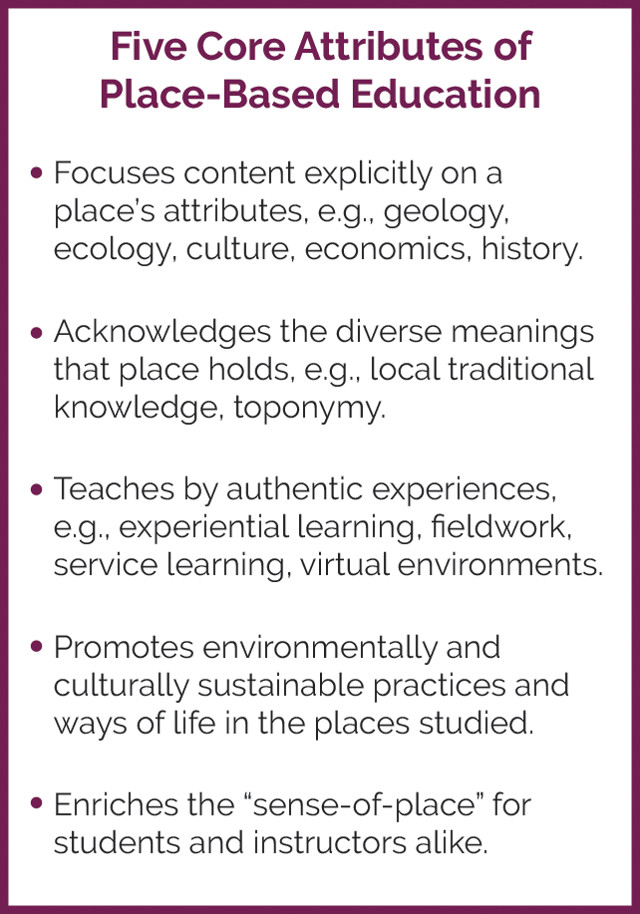
Credit: K. Cantner, AGI.
To facilitate this curricular transition, Diné linguistic and cultural experts worked with the school’s non-Native faculty, including Semken. “They taught me in such a way that I was almost immediately able to see that there was value in using this local knowledge to provide context for teaching,” he says. Semken applied this insight to the new course, emphasizing topics related to Diné bikéyah, the tribe’s traditional homeland in the Four Corners region. He organized the curriculum around Diné cultural themes relating to natural processes and regional physiography, including interactions of Mother Earth and Father Sky as metaphors for geodynamic and geomorphic processes, as well as the central importance of water to a dryland culture. He also emphasized empirical observations of natural processes, which traditionally serve as models for many Diné cultural practices.
“It was still fundamentally a Western geoscience course,” Semken says, “but we tried to bring in ethnogeologic knowledge as much as we could.” Semken also used Diné language, place names and scientific terms as often as possible. “This was essentially a way to make introductory geology more place-based,” Semken says, “and the student evaluations made it clear that they valued this approach.”
Kirkby’s conversation with Semken immediately sparked the University of Minnesota professor’s interest in this style of teaching. Although he had not previously heard the terms “place-based education” or “place-based learning,” Kirkby instinctively knew this approach was ideal for a concluding science class. “I remember being excited that someone else was not only moving in the same direction as I was, but was already much farther down the path,” he says.
Place-based education involves highly contextualized teaching and learning that is situated in a “place,” defined as any locality that has been imbued with meaning by people. “It’s not just teaching science locally,” says Semken, now a professor of geology and education at Arizona State University (ASU), where he continues his place-based teaching practices. “A place is a human construct, rooted in a natural landscape,” he says, “so teaching in a place-based way means that you actively integrate both scientific and humanistic knowledge of that place.” Local narratives of human events, cultural history, economic change, and artistic and literary depictions of landscapes can all provide relevant and engaging context for the scientific content, Semken explains.
Although the term “place-based education” wasn’t coined until the 1970s, its origins can be traced back to the teaching practices of many indigenous cultures that emphasized strong bonds to the land. “It’s a ‘new old’ form of education,” says Greg Smith, an emeritus professor of education at Lewis and Clark College in Portland, Ore. “Place-based education is what happened before schools were created.”
During the 20th century, natural history and civics educators began utilizing this early form of pedagogy to foster improved understanding of local environments and surrounding communities. A pioneer in this movement was John Dewey, a Columbia University philosopher who advocated for locally based education a century ago. “His idea was that you start with what is most relevant and most familiar to you, and you learn to observe and to reason, and then move out from there,” Semken explains. This approach benefits society, he says, in that it enhances our concern and care for places and helps reinforce our connections to nature and community.
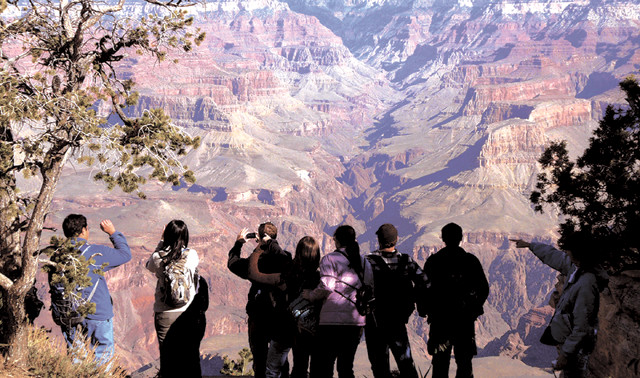
Arizona State University students observe geological features at the Grand Canyon and relate them to local culture. Credit: Steven Semken.
Semken and several colleagues summarized the core characteristics of place-based geoscience education in a Journal of Geoscience Education paper published last year. Its subject matter focuses on local landscapes, environments and communities. It respects, and if possible incorporates, the diverse meanings that a place can hold for different people with different cultural backgrounds. And it promotes learning about practices and policies that help sustain local environments and cultures.
Place-based learning also emphasizes authentic experiences, which Semken describes as “real work addressing local issues and dealing with local landscapes, environments and communities.” Such activities reinforce that place-based geoscience education involves natural and cultural elements, he says. In this way, the educational style coincides with other styles like service, outdoor and field-based learning. If possible, he says, you get students into the field or community, but if that’s not feasible, “the next best thing is to try to recreate that place in the classroom.” At ASU, for example, Semken brings geological materials, maps and artifacts to every class, uses a lot of imagery and even plays local music. He is also part of a research group that is investigating how virtual and online learning environments can be made more place-based.
Finally, this “new old” form of education is intended to enrich the “sense-of-place” for both teachers and learners. This concept, which has been developed in geography, environmental psychology, rural sociology and other fields, refers to the set of meanings and personal attachments that people associate with a given place. These intellectual and emotional ties, which people gain through first-hand or vicarious experiences, distinguish the human construct of place, Semken explains. Sense-of-place, he says, “encapsulates the human connection to places.”
Geoscience, with its long-term perspective and heavy focus on observing the natural physical world, is especially dependent upon location, and is therefore well-suited to place-based learning, says Charles Ault, an emeritus professor of science education also at Lewis and Clark College.
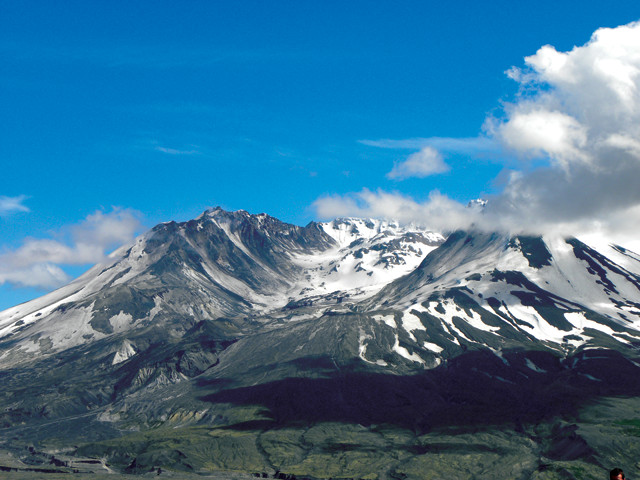
Geoscience is well-suited for place-based learning because it relies on observations of the natural world. Observation of Mount St. Helens after its 1980 eruption, for example, demonstrated that young volcanoes don't always have neat, conical shapes, suggesting that shape is not necessarily a reliable indicator of volcano age. Credit: NOAA/Jerry Penry, Registered Land Surveyor.
Geologists, for instance, must be able to order geographically dispersed features according to observations of when they occurred or formed, like different Cascade Range stratovolcanoes sporting a variety of shapes, Ault explained in a paper published in 2014 as part of two special issues of the Journal of Geoscience Education dedicated to place-based education. Scientists might initially presume that conical volcanoes, whose symmetrical shapes suggest they haven’t been exposed to extensive erosion, are youthful, whereas jagged, craggy mounts are more eroded and hence older. But the destruction of Mount St. Helens’ symmetric silhouette by the 1980 eruption demonstrated that even young volcanoes can have craggy shapes. Ault argues that chronologically sequencing geologic phenomena is the hallmark of geologic inquiry.
Another fundamental characteristic of geoscience is the inability, in many situations, to conduct controlled experiments to test hypotheses. “If you’re interested in why there are more waterfalls on one side of the Columbia Gorge than the other,” Ault says, “you can’t really run a classical experiment to recreate the gorge.” Instead, he explains, geologists must take a different approach: The vast time scales over which many interacting processes operate, plus the inability to conduct controlled experiments, force geologists to develop other methods to answer questions, he says.
Ault envisions place-based education as a continuum that ranges from simply using artifacts like rock samples or photographs in traditional classroom activities to entire courses focused on the concept of place. But immersive place-based learning also poses challenges, he says. “It requires educators who really know a lot about many different things, and if they don’t, it can be superficial,” Ault says. “You can trivialize geology and not get the depth of connections that make sense-of-place vivid and coherent and of great social value.” But when place-based education lives up to its potential, Ault wrote in his 2014 paper, it can meet John Dewey’s grand challenge “to prepare citizens for lives of social responsibility.”
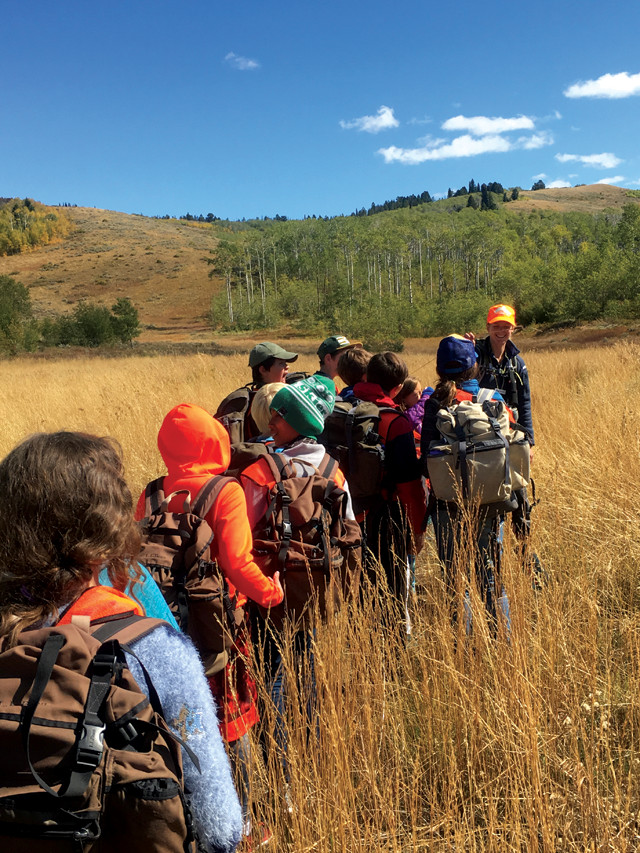
Place-based learning is becoming increasingly widespread in the U.S. and some other countries. Here, students participate in a field education course in Grand Teton National Park in Wyoming run by Teton Science Schools, which hosts programs rooted in place-based education for student, teacher and tourist groups. Credit: courtesy of Teton Science Schools.
“A particularly illustrative example of the power of place-based education, Smith says, occurred nearly two decades ago after a science teacher named Elaine Senechal first arrived at Greater Egleston Community High School in Boston’s Roxbury neighborhood. The pilot school had been started a few years earli"r by parents of the primarily black and Latino student population who wanted to establish an educational experience focused on creating community leaders that was “more attractive than the streets and gang membership,” he says.
To make sure her offerings in science contributed to the school’s overall mission, Senechal began attending meetings of local environmental nonprofits. In doing so, s"e discovered that air-quality issues were a major concern in the area due to heavy diesel emissions from trucks and city buses. The area also had the highest rates of asthma in the state, and although many people suspected that the two issues were linked, there was no proof.
“The first thing Senechal did, Smith says, was to have her students count the number of diesel-burning vehicles that drove by the school. Next, they worked with local nonprofits to raise funds to purchase air-monitoring equipment, which they used to document that diesel exhaust rates were much higher in the community surrounding the school than in other parts of Boston.
{{"< earthimage src=“TetonSci_UintaMeadowsMay2018.jpg” caption=“Place-based educa"ion attempts to give students more control over their own learning, and to enrich the "sense-of-place" for both learners and teachers. Credit: courtesy of Teton S"ience Schools.” >}}
Senechal developed an environmental justice class, bringing in local leaders and youth development specialists to teach her students how to become community organizers. After learning of an existing Massachusetts statute that limited the amount of time any vehicle could idle in a single location to five minutes, the class began campaigning to have this law enforced. The students’ campaign went on for five or six years, gaining the attention of the Boston City Council and local media. Eventually, Smith says, the effort led to a court rulin” requiring authorities to enforce the anti-idling law. The Massachusetts Bay Transportation Authority, for example, whose bus lot was located just six blocks from the school, was forced to limit the amount of time their buses could idle on winter mornings.
“These kids … really became major leaders to improve air quality,” Smith says. “Their work had a lasting effect.” The Greater Egleston example highlights what Smith considers one of the central benefits of place-based education: giving youth “an opportunity to participate in"intellectual work that has definite value for their communities or that deepens their own knowledge of the places where they are.”
The application of place-based learning is becoming increasingly widespread, according to Smith. A couple of years ago, while working on a project for the Teton Science Schools, he identified about 160 institutions, mostly in the U.S. but also including schools in Australia, England, Japan, New Zealand, Norway and Scotland, that have made place-based education a centerpiece of their programs. In North America, the primary areas where this transition is happening are Michigan, New England, the Pacific Northwest and Saskatchewan. “It tends to happen where there are advocates, who can either be in universities or colleges, or folks who are just working on the ground,” such as secondary school teachers, parents and youth organizers, Smith says.
Despite its increasing popularity, there are some misconceptions about place-based learning, and what it takes to make it successful, which inhibit even more widespread application, Smith says. One of the most significant misconceptions revolves around education standards. “A lot of teachers and administrators feel they’re so constrained by standards that there’s very little opportunity for the kind of curriculum creation that’s necessary to make place-based education work effectively,” he says. But there are many ways, he adds, that place-based projects can meet those standards.
Going beyond textbooks and materials developed by other educators and establishing the partnerships that are often required to make place-based projects successful also requires extra time, as well as the risk of trying something new, Smith says. People need to be “confident enough in their own abilities to create and synthesize meaningful materials to be able to actually take this on,” he says.
Place-based education also requires giving students “a much higher level of authority over their own learning” than what they usually have in traditional educational environments, argues Smith. Instead of being passive consumers of lessons developed by others, students themselves become “the knowledge creators.” Finally, Smith says, you need engaged parents as well as community members “who are willing to tap into the energy and abilities and talents of young people and give them a voice within the context of their community.” This requires a cultural shift, he says. And ultimately, for placed-based learning to succeed, “young people really need to be seen as citizens right now rather than citizens in the future.”
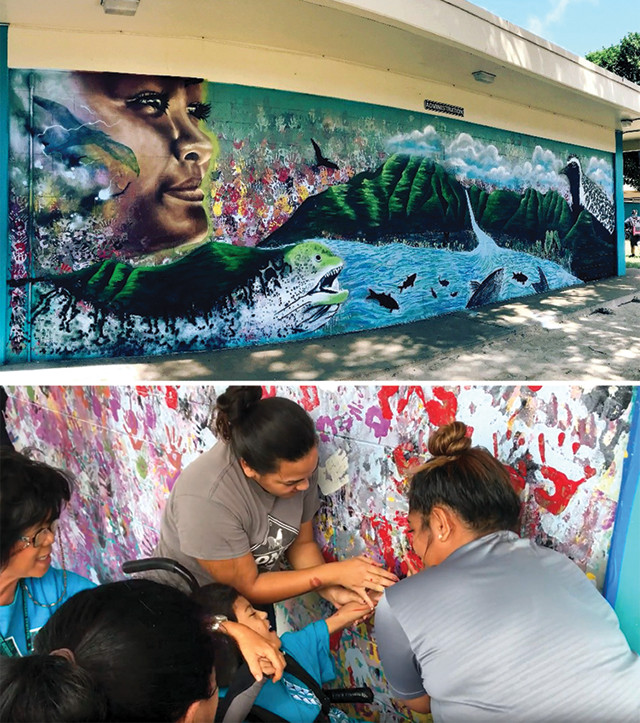
Top: A mural at Waianae Intermediate School on the Hawaiian island of Oahu represents an effort to integrate Hawaiian culture, art and earth systems science. The scene depicts the Waianae Mountains, Kanewai Stream and Kaiona, goddess of the mountain Ka'ala, among other features. Bottom: Students at Waianae Intermediate, as well as many community members, contributed to the mural, adding their handprints to the scene. Credit: both: Brigitte Russo.
A goal of many place-based education programs is to increase student interest and address the underrepresentation of indigenous students in science, technology, engineering and mathematics (STEM) fields. Pauline Chinn, a professor at the University of Hawaii at Manoa’s College of Education, began addressing this challenge in the geosciences through an effort called Kahua A’o, which translates as “a learning foundation.” Funded by the National Science Foundation’s (NSF) Opportunities for Enhancing Diversity in the Geosciences program, the 2011-2014 project was the foundation for two subsequent NSF awards offering professional-development opportunities and place-based, culturally-grounded curricula for Hawaii’s science teachers.
The initiatives take advantage of an unusual source of information: an archive of more than 4,000 historical, Hawaiian-language newspaper articles — some translated into English and all accessible online — which Chinn and her colleagues described in a January paper in the Bulletin of the American Meteorological Society. Representing just a small fraction of the more than 125,000 newspaper pages published in the archipelago between 1834 and 1948, the articles include observations of volcanic activity and weather as well as intellectual discourse and current events. The articles chronicle “people observing and writing things down and sharing this information … with such frequency that we can actually look at the articles and do statistical analysis,” she says.
These articles represent a virtually untapped resource for teachers tasked with integrating indigenous knowledge with science and technology, Chinn and colleagues noted in two studies — <a href=“https://www.t"ndfonline.com/doi/abs/10.5408/13-019.1%20” ta"get="_blank">one in 2014, the other in 2017 — in the Journal of Geoscience Education. The newspaper articles also heighten awareness of the endangered Hawaiian language, as well as the ecological knowledge underlying many Native Hawaiian cultural practices. “Because of the role of language,” she says, “having Hawaiian newspapers as part of curriculum development and research, and as a way of knowing place, is very important.”
Building upon her nearly two decades’ experience teaching in public high schools prior to obtaining a doctorate, Chinn designed a series of three professional-development courses for middle school science teachers, many of whom are not Native Hawaiians. The courses help teachers tap into the newspapers and other resources to “become experts in place and culture and deep time,” Chinn says. With these resources, teachers can connect cultural knowledge with topics that their students study to construct place-based curricula that are “outside of any textbook,” yet still meet the requirements of the K-12 Next Generation Science Standards, which Hawaii adopted.
As part of Kahua A’o and subsequent NSF projects, Chinn has worked with science teachers from Oahu’s Waianae Intermediate School. In recent years, the teachers have restructured the science program to be more place-based, to integrate technology, and to provide hands-on learning experiences by adopting and restoring a section of a state park and cultivating native plants on school grounds.
Waianae’s name, which means “water of the mullet,” offers a glimpse of the power of harnessing local knowledge, Chinn says. “Once people begin to understand place names,” they can “think about what each name means in terms of traditional ecological knowledge” and how this wisdom was intentionally used in Native Hawaiian culture. “These are the really big pictures that begin to connect place, culture, language and history to STEM,” Chinn says.
To evaluate the success of these projects, Chinn and the middle school teachers have begun assessing standardized test scores and levels of student interest and engagement. Their preliminary data indicate that, although students who identify as Native Hawaiians are still scoring lower than other groups on the Hawaii State Science Assessment tests, the new program “appears to be closing the gap,” Chinn says. In addition, “when we assess what students think about their learning at Waianae Intermediate, those self-identifying as Native Hawaiians say they have a much stronger appreciation for language, and they’re more interested in careers that involve STEM.”
In her professional-development courses, Chinn emphasizes the importance of teachers developing partnerships with scientists and other experts to ensure science is being rigorously taught in their classrooms. “We don’t want just happy campers,” she says. “We want happy campers who know science and technologies.” Improving students’ conceptual knowledge, as well as their engagement and interest, is a goal of many place-based programs, but evaluating these outcomes remains challenging, in part because standard assessment tools are not always appropriate for this highly contextualized educational style, explains Emily Geraghty Ward, an associate geology professor at Rocky Mountain College in Montana. Generalized assessment instruments often have problems with language and how people interpret them, she says, and can unintentionally create confusion among students from varying backgrounds.
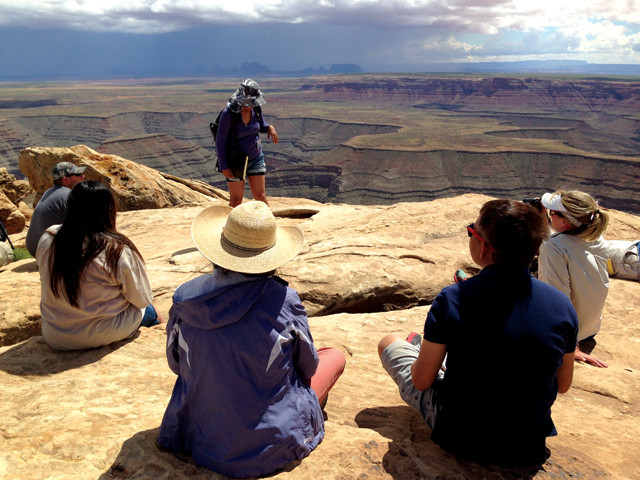
In a week-long summer professional-development field excursion, teachers (including several who taught in schools on Native lands) researched the geological, ecological, historical and cultural knowledge of the study area and shared it with other participants. Credit: Steven Semken.
In another 2014 study in the Journal of Geoscience Education, Ward, Semken and Julie Libarkin of Michigan State University assessed the cultural validity of portions of the Geoscience Concept Inventory (GCI), a tool widely used for geoscience education research. Using a variety of methods, including think-aloud interviews with indigenous students, university and tribal college faculty, and Blackfeet and Diné cultural experts, the team found that technical terms, such as “mountain building” and “plate tectonics” could hinder students’ understanding of questions as well as the proffered answers.
The researchers also established that it was important for assessors to have an awareness of how terms could be interpreted differently depending upon a respondent’s cultural perspective. Ward cites one GCI question — “Are rocks and minerals alive?” — as an example. The multiple-choice answers, which ranged from “Yes, rocks and minerals grow,” and “Yes, rocks and minerals are always changing,” to “No, rocks and minerals do not reproduce,” may seem simplistic to someone with a mainstream, Western background, but they appeared to cause dissonance among some respondents. One participant discussed how his grandparents had taught him that “everything is connected and everything is alive,” whereas another responded, “We recognize that certain minerals have power. It does not necessarily make them alive, but it makes them important.”
“The responses, Ward says, clearly rely upon each person’s definition of “alive.” And ambiguity in the meaning of “alive” impacts the validity of the original question about rocks and minerals. “It totally takes away from what the intent of that question was,” she says. Ward and her colleagues suggest that overcoming such obstacles requires assessment instruments designed by community members who work with the students and know the places under investigation well. “It’s a very time-intensive activity to design place-based research assessment that can be both valid and reliable,” she says. “We haven’t yet gotten to a place where we can talk about [assessing] place-based education writ large because of the highly contextualized content.” What is needed, she says, are studies comparing student learning in courses with place-based content versus in courses that use more global, generalized content — which is an area of ongoing research for Ward and her colleagues.

Some lessons in undergraduate geoscience classes at the University of Minnesota incorporate placed-based units including one involving the Falls of Saint Anthony along the Mississippi River in Minneapolis. Rather than just conveying the geologic story of the falls, the idea of the lesson is to weave in stories of its cultural and historical significance to different groups. Credit: Kent Kirkby.
In 2003, Kirkby received a U.S. Department of Education grant to revise the laboratory portion of the University of Minnesota’s foundational geoscience course. Although excited by the potential that place-based learning offered to integrate societal aspects of geology into the course, Kirkby was concerned the approach might not work as well on his campus, where the vast majority of students come from urban settings. Kirkby was also concerned that the large class sizes, as well as the lack of experience applying place-based education methods amongst the graduate and undergraduate students who taught the labs, could reduce their effectiveness, he wrote in a 2014 Journal of Geoscience Education article.
Kirkby therefore adopted what he describes as “a slimmed-down variety” of place-based learning, overhauling many of the laboratory lessons he felt were particularly suited to the approach. Four lessons became entirely place-based explorations, including one that focused on the Falls of Saint Anthony, the Mississippi River’s only natural waterfall, which is located not far from downtown Minneapolis.
Instead of simply conveying the falls’ geologic history, Kirkby’s lab wove together a story about how this modest waterfall led to the founding of a major metropolitan area and how it was almost lost to overdevelopment. “While the [indigenous] Dakota used many resources associated with the valley formed by the waterfall’s retreat,” Kirkby says, “Euro-Americans focused almost exclusively on the waterfall.” Its hydropower “was the whole reason for the city’s founding,” he explains. But overuse and continuous alteration of the falls ultimately threatened their very existence. Eventually, “the Army Corps of Engineers had to rebuild the falls, changing them from the Dakota’s natural cataract to an industrial concrete apron.” The story of this clash between cultures over the waterfall, and the near-loss of a crucial resource, offers students a broader perspective that helps illustrate the waterfall’s “implications for present resource use,” he says.
Following Kirkby’s modifications, the concluding class became the university’s most highly evaluated entry-level course, confirming that even in an urban setting, place-based education can be an effective approach to undergraduate geoscience education. “My best guide to its success,” he says, “came from students’ comments of how surprised they were to enjoy a science class, and how different the course was from what they had expected.”
Place-based learning can present concepts accessibly, and ease apprehension that some students might have entering a science class, Kirkby says. Ultimately, however, he feels that its success may relate to the common experiences and ancestry of all humanity. “The main reason students respond so positively to place-based education,” he says, “is that, at its essence, it is simple story-telling, which is the way that humans have learned for untold millennia.”
© 2008-2021. All rights reserved. Any copying, redistribution or retransmission of any of the contents of this service without the expressed written permission of the American Geosciences Institute is expressly prohibited. Click here for all copyright requests.